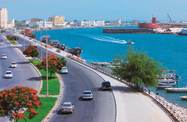The economy of Ras Al Khaimah (RAK) has continued to expand, and while final year-end 2012 figures for growth have yet to be released, officials say they are confident that the forecast 8% increase in GDP – the same rate as in 2011 – will have been achieved in the emirate.
This confidence was supported in late December when ratings agency Standard and Poor’s (S&P) affirmed its “A/A-1” long- and short-term foreign and local currency sovereign credit ratings for RAK. The agency said the rating was a reflection of the government's minimal expenditure responsibilities, prudent fiscal policy and ongoing indirect financial support from the central government of the UAE.
Fiscally, RAK was well protected against external shocks thanks to the UAE’s strong external balances and its system of fiscal transfers and banking coordination, according to S&P. Meanwhile, the emirate’s only domestic bank, RAK Bank, was cushioned from risk by being under the supervisory oversight of the Central Bank of the UAE. Looking forward, S&P said that the outlook for RAK was stable, thanks to the government’s fiscal flexibility and the advantages being in the UAE.
The industrial sector maintained its position as one of the leading contributors to the economy, with an input of around 30% to GDP. In August French firm Saverglass announced that it would be investing $93m to build a new production facility in RAK, joining at least three other major manufacturers of glass products based in the emirate.
Along with the ceramics sector, led by RAK Ceramics, which is recognised as the world’s largest ceramics manufacturer and the first regional ceramics firm to produce 1bn sq metres of tiles, the glass sector benefits from the easily accessible and competitively priced raw materials provided by the emirate’s mining industry. This sector also feeds RAK’s cement producers, who witnessed a rebound in 2012 as building activity in the UAE and across the Gulf began to pick up, pointing toward a recovery from the downturn brought on by the global financial crisis.
The emirate’s tourism sector also enjoyed a good year, with visitor numbers up and a surge in hotel construction to meet expected future demand. The RAK Tourism Development Authority estimates that up to 1.2m visitors will arrive in 2013, up from 835,000 in 2011, while the existing room stock will be expanded from just below 3000 to 10,000 by 2016.
This increase in tourist trade has in part been facilitated by the expansion of the emirate’s flag carrier, RAK Airways, which conducted a programme of route expansion during 2012 by adding four destinations and increasing the frequency of services on a number of existing routes. This was achieved in part through a code share arrangement struck with Etihad Airways in September.
In mid-December RAK Airways also announced it was expanding its domestic services to Abu Dhabi to include a daily flight, up from its four flights a week since it was re-launched in October 2012. The carrier has said it intends to lift flight numbers to twice a day in 2013 in anticipation of higher demand. The service, as the first domestic route in the UAE, has helped boost passenger numbers for RAK Airways; the airline has seen a 47% increase in seats sold as of the end of November.
Earlier in the year, RAK unveiled what it anticipates becoming the jewel in the crown of its tourism industry in the years to come, announcing that a $1bn combined theme park, sports and real estate project will be developed in partnership with Spanish football giant Real Madrid on Al Marjan Island, just off the emirate’s coast. Along with a 10,000-seat football stadium, a sports clinic and a museum, the complex will also include a series of resorts and residential complexes.
When announcing the project in March, RAK officials said they hoped the development – slated to be completed by the beginning of 2015 – would attract up to 1m visitors a year. If the project reaches its forecasted potential, it will provide a major boost to the domestic economy, positively impacting a range of sectors including transport, services, finance and retail.
Even without the additional sales that will be generated by the expected tourism boom, RAK’s retail sector is in the process of expanding, with gross leaseable area (GLA) set to total almost 200,000 square metres by 2015 – more than double the figure in 2010. Of this growth, 32,000 sq metres of GLA was added in April with the opening of the $110m RAK Mall, a development of the Abu Dhabi-based Lulu International Group.
While a return to regional and global financial instability cannot be ruled out, instability that would affect key sectors such as industry and tourism, the emirate has shown its economy to be relatively resilient to external shocks and it should be able to look toward solid growth in 2013.

